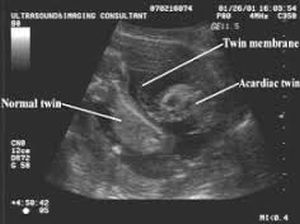

MedFriendly®


Acardiac Twin
Acardiac means without a heart. The term is used in
the context of an acardiac twin, which is a rare
complication (1 out of 35,000) of multiple simultaneous
pregnancies. While one twin develops normally, the
other is tissue that resembles a body but without an
upper body or heart. The lower body and legs tend to
be present. The twin who has a heart (known as the
pump twin) pumps blood to the second twin via
abnormal blood vessels located on the surface of the
placenta.
FEATURED BOOK: Essentials of Embryology and Birth Defects
The placenta is an organ in a woman that nourishes a baby during pregnancy. Because
one heart is doing the pumping action for two, this places the normal twin at risk for heart
failure and death. This risk of death increases as the acardiac twin’s size increases, the
blood flow to it increases, and the greater the normal twin’s heart needs to pump.
Ultrasound scanning can detect the size of the twins, the rate of blood flow, the strength
of heart pumping action, and early signs of heart failure. Ultrasound scanning is a
procedure that uses high-frequency sound waves to produce images of internal body
structures.
Death of the normal twin can be avoided if the twin is delivered at a point in pregnancy
when it can live outside the womb.
"Where Medical Information is Easy to Understand"™
There is another option known as fetal image-guided surgery
(FIGS-IT) which can be used if the acardiac twin has a large
enough heart and there is excessive blood flow to it. FIGS-IT uses
ultrasound scanning to guide a very thin needle to the blood
vessels supplying the acardiac twin. The needle (known as a
radiofrequency ablation needle) produces very high heat that
burns and destroys the blood vessels to the acardiac twin,
stopping the blood flow.
Acardiac comes from the Greek word "a" meaning "without" and the
Greek word "kardia" meaning "heart." Put the words together and
you get “without (a) heart.”
















